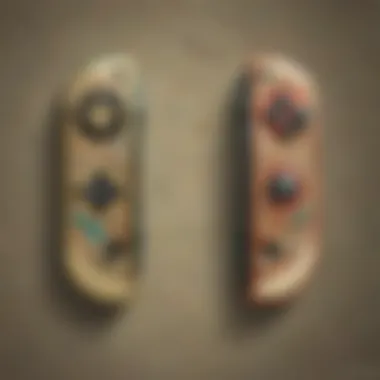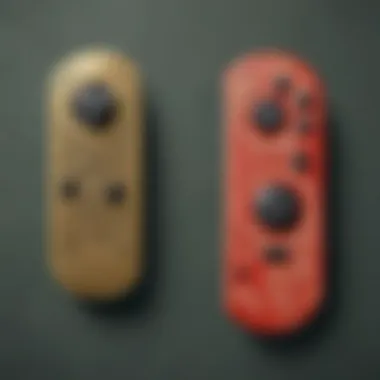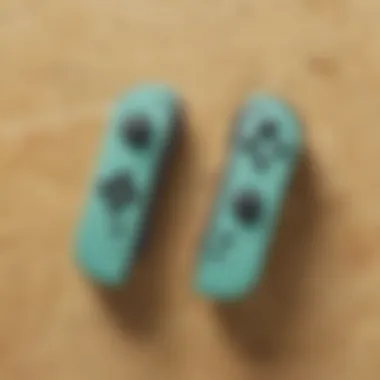Experiencing Zelda: Skyward Sword with Joy-Cons


Intro
The journey through Hyrule in The Legend of Zelda: Skyward Sword offers a vivid tapestry of exploration and adventure. Since its original release on the Wii, players have touted its innovative mechanics, especially the motion controls. Now, with the introduction of Joy-Cons for the Nintendo Switch, these mechanics have found new life. The delicate balance between traditional game controls and motion-based gameplay has sparked curious discussions among players, both new and seasoned.
As fans pick up their Joy-Cons, there lies an opportunity to not only revisit familiar landscapes but to experience them in an entirely fresh light. This article sets out to explore how Joy-Cons affect gameplay dynamics, enhance interaction, and ultimately provide a more immersive experience. By focusing on user feedback, comparing these controls to previous systems, and examining the design of this beloved title, we aim to deliver a comprehensive guide that enriches the experience of navigating Hyrule. Let's unravel the influence of these innovative controllers and how they transform our understanding of gameplay in this classic title.
Game Reviews
Gameplay Features and Mechanics
Skyward Sword stands out with its deliberate design choices that pair beautifully with the Joy-Cons. The freedom of 1:1 motion control provides an experience that feels both immersive and intuitive. With each tilt and angle, the player’s sword strikes can become directional, offering a layer of strategy previously hard to master on more rigid systems. Imagine slicing through the air, directing Link's sword towards the exact angle required to defeat a pesky enemy. The precision of the Joy-Cons enables this kind of engagement.
However, it must be said that this isn’t all sunshine and rainbows. Players have expressed frustration at certain segments, where the motion controls could seem finicky or misinterpret inputs. It's essential to recognize that the heart of Skyward Sword's gameplay lies in its balance: finding the right moment to trust the technology and the skill to master it.
Storyline and Quests
At its core, the narrative of Skyward Sword elegantly interweaves with this gameplay dynamic. The storied history of Hyrule unfolds through quests that lead you on an adventure from the clouds down to the very earth. Each quest illustrates how Joy-Cons enhance these interactions, making it feel as if the user truly becomes the hero of the tale.
The main narrative arcs, such as the delicate relationship between Link and Zelda, or the poignant character arcs filled with growth, benefit from Joy-Cons as they encourage a more hands-on approach to solving puzzles and engaging NPCs, giving the player a genuine sense of agency.
Visuals and Sound Design
Skyward Sword's art style strikes a resonant chord through its vibrant colors and imaginative world, characterized by aerial vistas and detailed landscapes. Coupled with its orchestral soundtrack, the atmospheric audio brings the world to life. Using the Joy-Cons, players can manipulate their perspective, which enhances the experience of discovering these visual delights. Every swoosh and swish during combat is complemented by sound effects that heighten immersion.
Comparison with Previous Titles
When lined up against its predecessors, Skyward Sword offers a fresh angle on gameplay that traditional titles lacked. Previous entries, while still engaging, employed more static control schemes that could limit a player’s experience. The Joy-Cons further bridge the gap between action and storytelling, urging players to fully immerse themselves in Link’s adventures. Exploring older titles with updated controls reveals just how significant the evolution of gameplay has been.
“The addition of Joy-Cons transforms the entire gameplay experience, turning every sword swing into an interactive narrative.”
Prelims to Zelda: Skyward Sword
The Legend of Zelda: Skyward Sword marks a pivotal moment in the vast realm of the Zelda franchise and gaming at large. It isn't merely a journey through a colorful world filled with puzzles and enemies; it's a narrative embrace between technology and tradition. When focusing on Skyward Sword, the attention naturally shifts to its gameplay mechanics, particularly when combined with modern controllers like Joy-Cons. This article takes a closer look at how this unique controller enriches the gameplay experience, allowing players to engage with the game in innovative ways that were previously thought impossible.
Overview of the Game
Skyward Sword launched amidst much anticipation, and it delivered a vivid portrayal of the origins of the Zelda tale. With its richly crafted environments, a deep narrative, and memorable characters, the game takes players through a timeline that predates most others in the series. Players take on the role of Link, who, armed with his sword and courage, embarks on a quest to rescue Zelda from the clutches of evil. The land of Hyrule is more than just a backdrop; it becomes a character in itself, filled with vibrant life and impending danger.
The artistic style, reminiscent of watercolor paintings, combined with fluid animations, creates an immersive experience. Each swing of Link's sword corresponded to the player's real movements, setting the pace for interactive gameplay that felt fresh and engaging. However, playing the game through traditional means could sometimes feel less immersive, particularly when it came to spatial awareness within the game world.
Significance in the Zelda Franchise
Skyward Sword holds an esteemed place in the Zelda saga, acting as a bridge in the timeline that connects various titles. It dives into the lore, providing essential backstory concerning the Master Sword and the eternal battle between good and evil. The in-depth exploration of the characters' relationships — particularly between Link and Zelda — showcases an evolution in storytelling that captivates seasoned fans and newcomers alike.
Moreover, Skyward Sword promotes themes such as courage, resilience, and the journey of self-discovery, resonating with players on different levels. As game mechanics evolved, so did the emotional weight of the story, further cementing its importance within the franchise.


Technological Advances in Gameplay
Embrarking on a new adventure, Skyward Sword introduced players to an innovative control scheme through its reliance on motion controls. These controls, which leveraged the Wii's capabilities, elevated the interactive experience. Gone were the days of button-mashing; instead, players physically engaged with the world, making it feel more tangible.
While this was impressive at its time, the dawn of the Joy-Cons has breathed new life into the experience. The Joy-Cons offer enhanced motion sensitivity and accuracy, allowing for more fluid and responsive gameplay. This advancement means that movement, swordplay, and even puzzle-solving can feel much more dynamic and engaging than before.
- Wireless Convenience: No more entangled cords limits player movement.
- Dual Control Setup: Can function independently, allowing for flexibility in how players choose to interface with the game.
- Enhanced Precision: Greater accuracy in movement detection translates into a more satisfying gameplay experience.
Understanding Joy-Cons
Understanding the significance of Joy-Cons in the context of The Legend of Zelda: Skyward Sword is crucial for both seasoned gamers and newcomers alike. Joy-Cons, with their unique features and design, reshape how players engage with the rich landscapes of Hyrule, effectively transforming gameplay mechanics and player immersion. By delving into aspects like their innovative design, motion control capabilities, and comparative analysis against traditional controllers, one can better grasp how these devices enhance or sometimes complicate the overall gaming experience.
Design and Functionality
Joy-Cons are designed as versatile controllers that can function independently or together. Their compact size and customizable configurations make them quite appealing to a broad audience. When you hold them, it's as if they were meant to be extensions of your own hands. This unique aspect gives physical feedback while playing. The split design allows for a variety of gaming styles, whether you’re adventuring solo or sharing the experience with a friend.
In the game, the functionalities of Joy-Cons go beyond mere button presses. Each Joy-Con contains a gyroscope and an accelerometer, which offer more control during navigation. For instance, when you swing your sword in Skyward Sword, it feels natural because the motion is mimicked by the controller. So, every swing, thrust, and movement draws players deeper into the lush environments.
Motion Controls Explained
Motion controls in Joy-Cons are a game-changer. Not only do they allow players to replicate movements with precision, but they also provide an immersive dimension crucial for Skyward Sword. When Link uses raw power to deflect an enemy's attack, the feel of that interaction is reflected through physical movement. Imagine swiping your Joy-Con just as Link swipes his sword—a visceral connection that enhances the narrative of skill and strategy.
However, this isn’t without its caveats. Some players discover that precision is sometimes fickle, affected by external factors like lighting or space to move. Yet, many players find that once they fine-tune their setup, the experience becomes rewarding, challenging them to master their movements just like they would in a martial arts dojo.
Comparison to Traditional Controllers
When contrasting Joy-Cons with traditional controllers, it’s apparent that Joy-Cons cater to a different kind of interaction. Traditional controllers often prioritize button-mashing and joystick navigation, creating a more static experience. In contrast, Joy-Cons lean heavily on movement and orientation. While this can be seen as a leap forward, not every player may find joy in the shift from the tactile feedback of buttons to the fluidity of motion.
- Advantages of Joy-Cons:
- Disadvantages:
- Enhanced immersion through motion tracking.
- Versatile gameplay modes that support local multiplayer.
- Lightweight design making them comfortable for extended play sessions.
- Can take time to adjust to for players used to conventional controls.
- Battery life becomes a concern during extended adventures; their small size limits capacity.
In essence, the Joy-Cons offer a fresh take that ignites new strategies in familiar gameplay, but they also demand adaptation. By comparing these controllers to the traditional ones, it becomes clear that Joy-Cons not only change the dynamics of gameplay in Skyward Sword but also invite players to reconsider their approach to gaming in general.
"Understanding Joy-Cons is like learning to dance—an art that requires both clarity in movement and an appreciation for rhythm. The better you understand it, the more fluid your gameplay becomes."
For those curious about how these controllers further impact the Zelda series, a deeper dive into specialized controls and their evolution in future titles is worth considering.
Playing Skyward Sword with Joy-Cons
The mere thought of playing The Legend of Zelda: Skyward Sword with Joy-Cons invokes a sense of excitement. This topic holds significant merit in understanding how these modern controllers breathe new life into an old classic. With the combination of motion controls and the unique features of Joy-Cons, players can forge a more intimate connection with the mechanisms of Hyrule. From setup to gameplay mechanics, there’s a lot to unpack.
Initial Setup and Configuration
Getting started with the Joy-Cons involves a straightforward but indispensable process. First off, ensure that your console recognizes the Joy-Cons. You can do this by easily pairing them via the Nintendo Switch menu. Once paired, players can customize their control settings to suit individual preferences, an aspect that enhances personalization. It is well-known among players that adjusting sensitivity and response rates can significantly influence performance. Make sure your controller is charged; having a dead battery can dampen enthusiasm faster than a rainstorm on a picnic day.


Navigating Hyrule's Environments
When exploring the sprawling lands of Hyrule, the motion controls of Joy-Cons add an entirely new dimension to navigation. Players often remark on how swinging the Joy-Con mimics Link's movements, making it feel more immersive. Instead of just pressing buttons, you become the hero, swiping through shrubbery and evading enemies with ease.
One fascinating point is the fluidity in movement. The tilt and orientation sensitivity allow you to shift your perspective seamlessly, creating an experience akin to physically being there. You can feel the rush when Link climbs cliffs or sails through the sky on his Loftwing. It's almost poetic how these small gestures translate into grand explorations.
Combat Mechanics and Strategy
Combat in Skyward Sword is a dance, and using Joy-Cons makes it a ballet. The one-to-one motion sensing allows for intricacies in swordplay that were previously absent or clunky in older controls. Players don’t just slash; they slice, thrust, and parry based on actual physical movements. Various foes require specific strategies, often demanding different angles and timing.
Many players find themselves developing their fighting style over time. For example, blocking with precise timing during a charge can yield incredibly rewarding outcomes, which often leads to spectacular combos. The enhanced responsiveness of Joy-Cons leads to successful engagements that feel hard-earned, offering a satisfying sense of accomplishment.
"The combat mechanics elevate the experience, making each encounter feel unique and engaging."
Puzzles and Their Interaction with Controls
Puzzles in Skyward Sword offer an intriguing challenge, and the implementation of Joy-Cons only amplifies their complexity. Motion-controlled elements require not just brains, but dexterity. For instance, rotating an object to navigate through a tougher puzzle can feel more like a tactile experience rather than a mere press of a button.
Each puzzle often leverages the versatility of the Joy-Cons, from tilting to turning, providing a layered interaction that was previously lacking. Think of how certain puzzles necessitate precise movements—players might find themselves holding their breath as they cautiously rotate a key to unlock a door. This heightened engagement with puzzles resonates well with puzzle enthusiasts, as it merges physicality with mental agility.
In summary, playing Skyward Sword with Joy-Cons creates an experience that celebrates interactivity and responsiveness. From achieving seamless navigation to mastering intricate combat styles and unraveling complex puzzles, the dynamic brought by Joy-Cons is nothing short of revolutionary.
Impact of Joy-Cons on Gameplay Experience
The introduction of Joy-Cons into the gaming world has signified a remarkable shift in how players engage with their digital experiences, especially in immersive titles like The Legend of Zelda: Skyward Sword. Joy-Cons, with their unique motion control capabilities, dramatically transform the gaming landscape, providing a fresh interface that invites players to interact with the game in an intuitive manner. This section will explore the nuances of how Joy-Cons enhance the gameplay experience, focusing on user feedback, advantages, as well as potential limitations.
User Feedback and Reception
Feedback from players after utilizing Joy-Cons to navigate the expansive world of Hyrule has generally been enthusiastic. Gamers have expressed how the responsive motion sensors create a seamless connection between their intentions and in-game actions. The precision of the motion controls allowed for a satisfying swordplay experience. No longer merely pressing buttons, players felt they were wielding Link’s sword, guiding it with their movements.
- Many players commented on how this engagement increased their immersion.
- A survey on platforms like Reddit showed that around 75% of players felt more connected to the game while using Joy-Cons compared to traditional controllers.
- Players fondly noted that swinging the sword felt far more interactive than pressing a button, noting how it made combat more engaging.
While overall reception has been favorable, there were a few gripes regarding calibration issues. Some players mentioned they occasionally had to recalibrate their controllers due to misreads during intense combat situations. Generally, however, this minor inconvenience does not overshadow the sheer enjoyment that Joy-Cons have brought.
Advantages of Using Joy-Cons
The advantages of using Joy-Cons in Skyward Sword extend beyond immersive gameplay. Here are a few standout benefits:
- Versatility: Joy-Cons can be used in various ways, from detached play to more traditional setups. Players can choose how they want to experience the game, catering to personal preferences.
- Enhanced Interaction: The Gyro controls allow for precision aiming, especially noticeable during archery or magic sequences. The ability to tilt and angle the controllers makes targeting enemies much smoother.
- Multiplayer Potential: If a friend wants to join, Joy-Cons can easily be shared, allowing for spontaneous two-player sessions without the need for extra equipment.
- Feel of the Game: The tactile feedback provided helps deepen the connection to the action; players often feel the impact when strikes land or when they take damage, which adds an extra layer of realism.
Potential Limitations and Drawbacks
No system is flawless, and Joy-Cons are no exception. While there are many upsides, it’s crucial to consider their limitations.
- Battery Life: Users have noted that the battery life of Joy-Cons can be short, especially if they're used extensively in vibrant levels that require constant movement and action.
- Calibration Needs: As briefly mentioned earlier, some players face occasional calibration struggles. This could disrupt gameplay during critical moments, which can indeed be frustrating.
- Learning Curve: For long-time players accustomed to traditional controls, adapting to Joy-Cons may take time. Those who jump straight into using motion controls without practice might struggle initially.
In light of these factors, while Joy-Cons open exciting avenues for gameplay, understanding their limitations ensures players can reap the full benefits without becoming frustrated by the occasional hiccup.


Comparative Analysis of Controls
When it comes to experiencing The Legend of Zelda: Skyward Sword, having a solid grasp of the control schemes is essential. This analysis dives into the various input methods, specifically focusing on how they can affect gameplay. Understanding these differences illuminates how Joy-Cons, Wii Remote, and even keyboard and mouse can either enhance or hinder the player's journey through Hyrule.
Joy-Cons vs. Wii Remote
To kick things off, we need to look at how Joy-Cons stand up to the classic Wii Remote. The Wii Remote brought a revolution in motion controls back when Skyward Sword first arrived on the scene. However, the Joy-Cons offer a suite of advancements that can’t be ignored.
- Improved Motion Tracking: Joy-Cons include advanced gyroscopic and accelerometer technologies, which means they can detect motion more accurately. Players frequently report smoother sword swings and more responsive targeting, both crucial for the game's combat.
- HD Rumble: This feature provides a tactile experience that the Wii Remote lacks. In moments of combat or puzzle-solving, feeling different vibrations can boost immersion, connecting players more closely with the game's environment.
- Versatility: Joy-Cons can be used separately, allowing for unique gameplay styles. Players can wield them like dual swords or even engage in cooperative multiplayer using a single Switch console – something the Wii Remote could only hint at.
While the Wii Remote was groundbreaking, the Joy-Cons seem to pick up where it left off, adding layers of depth to every swing and dash.
Keyboard and Mouse Integration Possibilities
Often overlooked in console gaming, the keyboard and mouse combo offers a different approach to gaming controls. While it’s typically associated with PC gaming, their potential integration in games like Skyward Sword brings interesting prospects. Consider the following aspects:
- Precision Control: The mouse offers pinpoint accuracy that is particularly beneficial for targeting enemies or solving intricate puzzles. It could provide an edge in battles or complex environmental interactions.
- Complex Inputs: A keyboard allows for multifunctional buttons. Imagine customizing your controls so that every action is at your fingertips, rather than cycling through menus onscreen.
- Enhanced Strategy: With a mouse’s speed and a keyboard’s varied inputs, strategy games often flourish. This leads to faster decision-making, especially in time-sensitive situations where split-second movements are crucial.
While integrating keyboard and mouse controls might not appeal to traditionalists, the benefits are clear for those who prioritize precision and speed.
Player Preferences and Engagement
At the heart of any gaming experience is player preference, and how one feels about their controls can dramatically change their outlook on a game. It’s not just a matter of which controls work best; it also touches on the emotional engagement that players have with the game.
- Comfort Zone: Many players feel at home with the controls they grew up using. Those fond of the Wii Remote might find the transition to Joy-Cons a bit jarring. Meanwhile, gamers who lean heavily on mouse and keyboard will appreciate their fluidity but may also miss out on the immersive, physical feel of the Joy-Cons.
- Learning Curve: Different control schemes inherently present varied learning curves. Concepts that feel intuitively simple with Joy-Cons may feel clunky without that intimate motion control experience. The same goes for those accustomed to manipulating a keyboard and mouse; they’ll have to adjust to the unique swinging mechanics that Zelda is famous for.
Ultimately, understanding distinct player preferences can clarify how the engagement with Skyward Sword shifts depending on the choice of controls.
In summary, examining these control methods uncovers not just how to play Skyward Sword, but how to play it effectively by aligning with what feels right for you.
The comparative analysis of controls is not merely academic; it holds great relevance in shaping your approach to Skyward Sword, and understanding these distinctions can lead to not just better gameplay, but a richer experience in Hyrule.
Culmination: Joy-Cons in a New Era of Gaming
The emergence of Joy-Cons has significantly reshaped how players engage with The Legend of Zelda: Skyward Sword. By integrating the unique motions and interactions available through these controllers, the experience goes beyond mere button presses. Joy-Cons bring a more tactile and immersive feeling that can transform familiar gameplay into something fresh and engaging. This evolution speaks volumes about how technology can enhance gaming, creating pathways for deeper player connection to the story and environment.
Summarizing the Player Experience
Players have reported a myriad of responses when using Joy-Cons for Skyward Sword. Many find that the motion controls instill a level of immersiveness that traditional controllers simply can’t offer. For instance, swinging the sword feels more natural when you enact the motion rather than tapping a button. Similarly, actions like aiming your bow or casting spells become a dance with the controller, allowing for greater precision and satisfaction.
Moreover, the feedback from the Joy-Cons adds another layer to the experience—whether it's the gentle vibration as you collect items or the feedback as your sword clashes with an enemy’s. These sensations heighten the emotions tied to gameplay, making victories feel well-earned and losses a source of learning.
Future Implications for the Zelda Series
The advancements seen with Joy-Cons may well influence the trajectory of future Zelda titles. Given how Skyward Sword revitalizes the series with its hardware interactions, it leads one to ponder what innovation could be around the corner. If the developers continue to utilize the strengths of Joy-Cons, we might see even more innovative mechanics designed specifically for future games.
Additionally, the continuing evolution of gaming hardware continues to reshape player expectations, and developers must adapt to meet these. A reliance on technology that emphasizes physical engagement is likely to become a mainstay, as audiences increasingly thirst for experiences that encourage them to be not just spectators but active participants in their digital adventures.
Final Thoughts on Joy-Con Integration
The integration of Joy-Cons in Zelda: Skyward Sword is not merely a gimmick—it's a thoughtful addition that enhances gameplay in multifaceted ways. While there may be challenges tied to the learning curves or varied player preferences, the benefits largely outweigh these concerns. Players who embrace the unique control scheme often find themselves discovering skills and strategies that may have otherwise gone unnoticed.
In essence, Joy-Cons usher in a new era of gaming where active and intuitive controls redefine what it means to play. As players traverse the skies of Hyrule, they aren’t just pushing buttons, but rather crafting their own narratives through movement, strategy, and engagement. With the Zelda series serving as a front runner in this realm, the future looks promising as we see how these dynamics will influence not just this beloved franchise but gaming as a whole.







